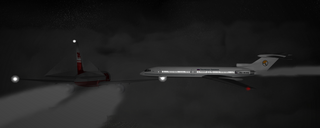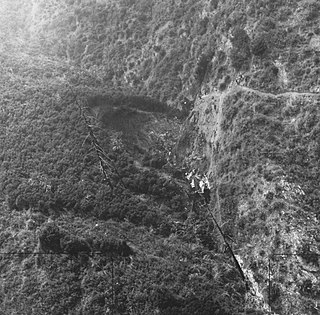
On 1 July 2002, BALBashkirian Airlines Flight 2937, a Tupolev Tu-154 passenger jet, and DHL International Aviation ME Flight 611, a Boeing 757 cargo jet, collided in mid-air over Überlingen, a southern German town on Lake Constance, near the Swiss border. All of the passengers and crew aboard both planes were killed, resulting in a total death toll of 71.

On 12 November 1996, Saudia Flight 763, a Boeing 747 en route from Delhi, India, to Dhahran, Saudi Arabia, and Kazakhstan Airlines Flight 1907, an Ilyushin Il-76 en route from Chimkent, Kazakhstan, to Delhi, collided over the city of Charkhi Dadri, around 100 km west of Delhi. The crash killed all 349 people on board both planes, making it the world's deadliest mid-air collision and the deadliest aviation accident ever in India. The final report from the investigation found that "[T]he root and approximate cause of the collision" was the failure of the Kazakh crew to maintain the correct altitude. Contributing factors included the poor English language skills in the Kazakh cockpit resulting in inadequate interpretation of directions provided by air traffic control, and three specific incidents of failures in crew resource management (CRM) by the Kazakh crew. The report also suggested technical enhancements that would provide assistance in preventing a future crew's mistakes being allowed to go unchecked in real time.

On December 16, 1960, a United Airlines Douglas DC-8 bound for Idlewild Airport in New York City collided in midair with a TWA Lockheed L-1049 Super Constellation descending toward LaGuardia Airport. The Constellation crashed on Miller Field in Staten Island and the DC-8 in Park Slope, Brooklyn, killing all 128 aboard the two aircraft and six people on the ground. The accident was the world's deadliest aviation disaster at the time, and remains the deadliest accident in the history of United Airlines.

United Air Lines Flight 409 was a scheduled flight which originated in New York City, New York. The final flight destination was San Francisco, California, with stops in Chicago, Denver and Salt Lake City. The aircraft operating the service, a Douglas DC-4 propliner, registration N30062, crashed into Medicine Bow Peak, near Laramie, Wyoming, on October 6, 1955, killing all 66 people on board. The victims included five female members of the Mormon Tabernacle Choir and military personnel. At the time, this was the deadliest airline crash in the history of American commercial aviation. Another 66 lives had been lost earlier that year in the March 22 crash in Hawaii of a United States Navy Douglas R6D-1 Liftmaster military transport aircraft, and 66 had also died in the mid-air collision of two United States Air Force C-119G Flying Boxcars over West Germany on August 11, placing the three crashes in a three-way tie as the deadliest aviation incidents in 1955.
Grand Canyon Airlines is a 14 CFR Part 135 air carrier headquartered on the grounds of Boulder City Municipal Airport in Boulder City, Nevada, United States. It also has bases at Grand Canyon National Park Airport and Page Municipal Airport, both in Arizona. It operates sightseeing tours and charter service over and around the Grand Canyon. Its headquarters and main operation center is Grand Canyon National Park Airport and Boulder City Municipal Airport. The company slogan is With Grand Canyon Airlines, Your Memories are Cleared for Takeoff!

On 29 September 2006, Gol Transportes Aéreos Flight 1907, a Boeing 737-800 on a scheduled domestic passenger flight from Manaus, Brazil, to Brasília and Rio de Janeiro, collided mid-air with an Embraer Legacy 600 business jet flying on an opposite heading over the Brazilian state of Mato Grosso. The winglet of the Legacy sliced off about half of the 737's left wing, causing the 737 to break up and crash into an area of dense jungle, killing all 154 passengers and crew. Despite sustaining serious damage to its left wing and tail, the Legacy landed with its seven occupants uninjured.

In aviation, a mid-air collision is an accident in which two or more aircraft come into unplanned contact during flight. Owing to the relatively high velocities involved and the likelihood of subsequent impact with the ground or sea, very severe damage or the total destruction of at least one of the aircraft usually results.

Hughes Airwest Flight 706 was a regularly scheduled flight operated by American domestic airline Hughes Airwest from Los Angeles, California to Seattle, Washington, with several intermediate stops. On Sunday, June 6, 1971, the McDonnell Douglas DC-9 serving as Flight 706 departed Los Angeles just after 6 p.m. en route to Seattle as a McDonnell Douglas F-4 Phantom II of the United States Marine Corps was approaching Marine Corps Air Station El Toro near Irvine at the end of a flight from Naval Air Station Fallon in Nevada. The two aircraft collided in midair over the San Gabriel Mountains near Duarte, killing all 49 aboard the DC-9 and the F-4 pilot; the F-4 radar intercept officer ejected and survived.

The Grand Canyon mid-air collision occurred in the western United States on June 30, 1956, when a United Airlines Douglas DC-7 struck a Trans World Airlines Lockheed L-1049 Super Constellation over Grand Canyon National Park, Arizona. The first plane fell into the canyon while the other slammed into a rock face. All 128 on board both airplanes perished, making it the first commercial airline incident to exceed one hundred fatalities. The airplanes had departed Los Angeles International Airport minutes apart from each other and headed for Chicago and Kansas City, respectively. The collision took place in uncontrolled airspace, where it was the pilots' responsibility to maintain separation. This highlighted the antiquated state of air traffic control, which became the focus of major aviation reforms.

The Federal Aviation Act of 1958 was an act of the United States Congress, signed by President Dwight D. Eisenhower, that created the Federal Aviation Agency and abolished its predecessor, the Civil Aeronautics Administration (CAA). The act empowered the FAA to oversee and regulate safety in the airline industry and the use of American airspace by both military aircraft and civilian aircraft.

On August 8, 2009, at 11:53 a.m. (15:53 UTC), nine people died when a tour helicopter and a small private airplane collided over the Hudson River near Frank Sinatra Park in Hoboken, New Jersey, United States. The aircraft were in an area known as the "Hudson River VFR Corridor", which extends from the surface of the river to altitudes of 800 to 1,500 ft at various locations along the Hudson River in the immediate area of New York City. Within this corridor, aircraft operate under visual flight rules (VFR), under which the responsibility to see and avoid other air traffic rests with the individual pilots rather than with the air traffic controller (ATC).

American Airlines Flight 28 was a scheduled domestic passenger flight that crashed on October 23, 1942, in Chino Canyon near Palm Springs, California, United States, after being struck by a United States Army Air Forces B-34 bomber. The B-34 suffered only minor damage, and landed safely at the Army Airport of the Sixth Ferrying Command, Palm Springs.

United Air Lines Flight 736 was a scheduled transcontinental passenger service flown daily by United Airlines between Los Angeles and New York City. On April 21, 1958, the airliner assigned to the flight, a Douglas DC-7 with 47 on board, was flying over Clark County, Nevada in clear weather when it was involved in a daytime mid-air collision with a United States Air Force fighter jet crewed by two pilots. Both aircraft fell out of control from 21,000 feet (6,400 m) and crashed into unpopulated desert terrain southwest of Las Vegas, leaving no survivors. The loss of Flight 736, one of a series of 1950s mid-air collisions involving passenger aircraft in American skies, helped usher-in widespread improvements in air traffic control within the United States, and led to a sweeping reorganization of federal government aviation authorities.

The Grand Canyon mid-air collision occurred when Grand Canyon Airlines Flight 6, a de Havilland Canada DHC-6 Twin Otter, collided with a Bell 206 helicopter, Helitech Flight 2, over Grand Canyon National Park on June 18, 1986. All 25 passengers and crew on board the two aircraft were killed. It remains the deadliest accident involving a helicopter on United States soil, surpassing the crash of Los Angeles Airways Flight 841 in 1968, which killed 23 people.

ADC Airlines Flight 086 (ADK086) was a Nigerian domestic flight operated by ADC Airlines from Port Harcourt to Lagos. On the afternoon of 7 November 1996, the crew of the Boeing 727-200 operating the flight lost control of the aircraft while avoiding a mid-air collision on approach; the aircraft crashed inverted at a very high speed into a lagoon, killing all 144 passengers and crew on board. The crash remains as the fourth worst plane crash in Nigerian history.

On November 10, 1985, a Dassault Falcon 50 executive jet belonging to Nabisco Brands Inc. and a Piper Cherokee collided over Teterboro Airport in New Jersey. Six people died in the accident: all five aboard both aircraft and one person on the ground; another eight were injured.

On 13 September 1997, a German Air Force Tupolev Tu-154M observation aircraft and a United States Air Force C-141B Starlifter transport aircraft were destroyed in a mid-air collision while cruising at 35,000 feet (11,000 m) off the coast of Namibia. All 33 people onboard both aircraft were killed. At the time of the collision, the Tupolev was flying on a southerly route from Niamey, Niger, to Cape Town, South Africa, while the C-141 was heading northwest from Windhoek, Namibia, to Ascension Island.

The 2020 Alaska mid-air collision occurred at approximately 8:27 a.m. on July 31, 2020, when a de Havilland DHC-2 Beaver collided with a Piper PA-12 over the Kenai Peninsula, Alaska, approximately two miles northeast of Soldotna Airport, near mile 91.5 of the Sterling Highway. Most of the wreckage landed about 200 yards (180 m) from the road. Alaska State Representative Gary Knopp was piloting one of the aircraft and was killed in the accident.
















